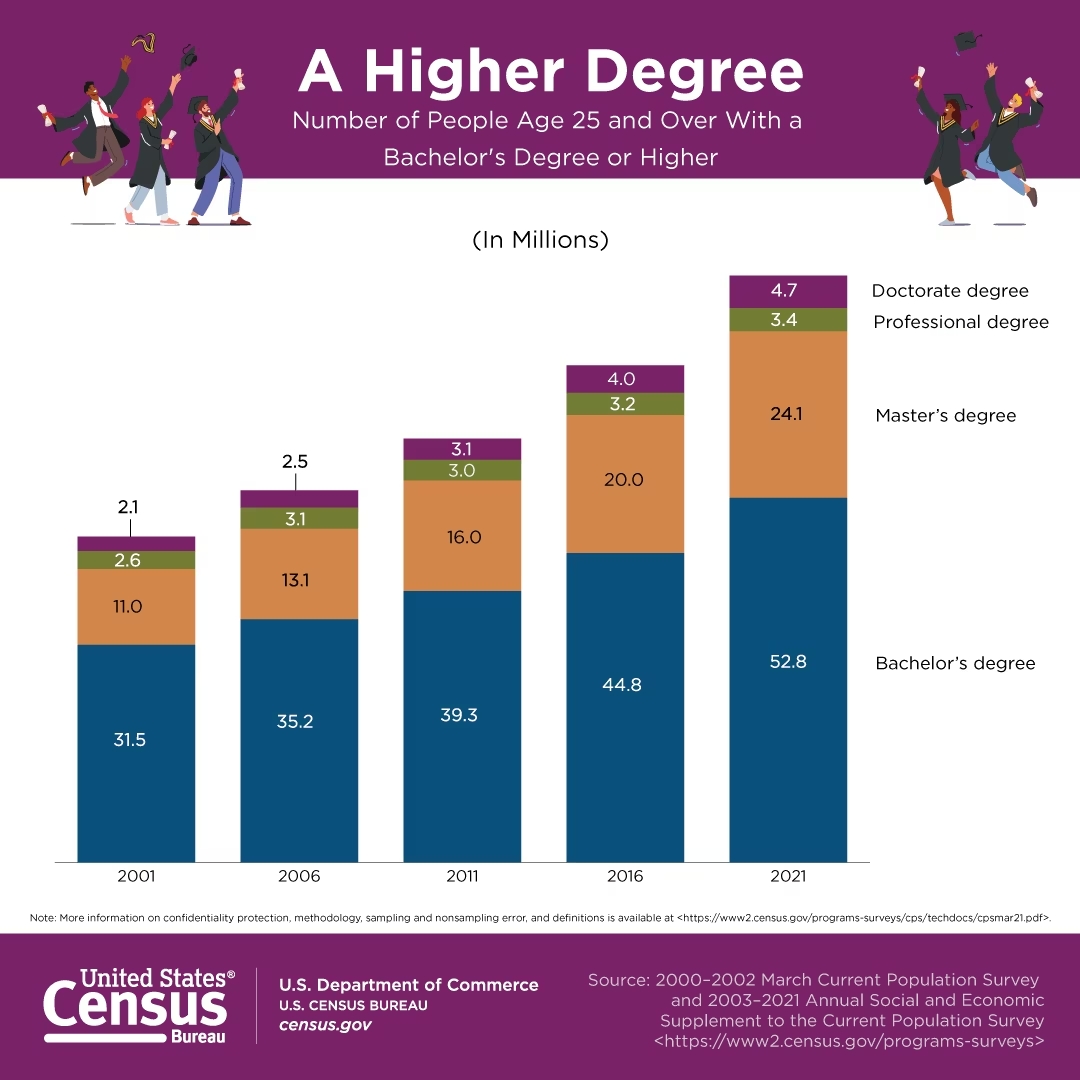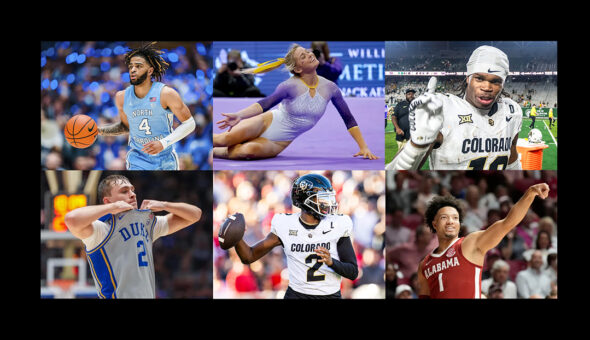As the new calendar year approaches and campuses around the nation have returned with ardor to pre-pandemic normalcy, one upward trend that continues to steadily increase is the number of adults that hold both bachelors and graduate degrees. As of 2021, 37.9% of Americans 25 and older have a bachelor’s degree, and 14.3% have also obtained a graduate or professional degree, according to the Census Bureau’s Current Population Survey.
2023 Hot and Cool Graduate Programs
As interests and technology change, more students are rethinking their graduate programs to align with money-making potential and personal fulfillment.

Hot Programs
Postsecondary institutions in the United States have conferred about a million graduate degrees, an increase of 21% since 2009-2010. These included 843,400 master’s degrees and 190,200 doctor’s degrees. In the past decade, five areas of study have routinely accrued the highest number of graduate students.
- business
- education
- health professions and related programs
- computer and information sciences and support services
- public information and social services
The Institute of Education Sciences National Center for Education Statistics reported that in the 2019/2020 school year, over half of the master’s degrees were earned in the top three fields of study: business (23%), education (17%) and health professions and related programs (16%). Since 2000, the number of people aged 25 and older whose highest degree was a master’s has doubled to 21 million, the U.S. Census Bureau reported as of 2021.
The number of doctoral degree holders has more than doubled to 4.5 million as of last year. As business, education and health profession graduate degrees yield some of the nation’s highest salaries, the market consistently demonstrates that a majority of American students factor in a stable financial future in deciding whether or not to pursue a graduate or postdoctoral degree — and more importantly, what to pursue if they decide to.
However, although the five most popular programs may boast the largest numbers, many university professionals have pointed out that there is inherent value in many smaller, niche programs, where students highly dedicated and focused on a specific subset of study can truly delve into their world, connecting with valuable peers and mentors.
“For us, the size of a program doesn’t necessarily reflect its success. We deliberately cap the size of some programs. I have heard anecdotally that many traditional pharmacy programs across the nations are facing challenges since COVID started,” said Anne Gregory, Director of Communications and Media Relations at Manchester University in Fort Wayne, Indiana. “We have the nation’s most popular master’s degree program in pharmacogenomics (PGx) and are starting a related master’s degree in nutrition with a DNA twist. For now, though, I think you would consider them to be niche health science programs. We believe both will be big nationwide, once people realize that their personal genomics react differently to different kinds of medication and food—and that they can optimize both.”
To continue consistent enrollment in graduate programs, many universities have heavily reformed what they offer for a student’s experience. Volt previously reported that organizations like the University Innovation Alliance are building out intentional plans to eliminate the disparity between marginalized students and create more inclusive campuses overall. Although offering the most sought-after graduate programs helps maintain interest, it’s often equally important for universities to get rid of their least popular programs, allocating more resources to the degrees that students most want to earn.

Cooling Programs
Although it is important to recognize the graduate programs that are most sought after, it is equally important to analyze the programs that are steadily declining in popularity and enrollment. These trends signal the departments in which universities could concentrate their efforts to attract more candidates, or it could demonstrate a shift in the current American economy, in which fewer students are deciding to pursue higher education in historically lower-paying professions every year.
According to the 2021 CGS/GRE Survey of Graduate Enrollment and Degrees, four degrees were the least popular in terms of first-time graduate enrollments by broad field of study and attendance status:
- public administration
- biological and agricultural sciences
- arts and humanities
- physical and earth sciences
“We really haven’t seen a major decline in popularity for any of our programs, mostly because we keep on top of any changing credential requirements for programs and adjust our programs accordingly,” said Michelle Fryling, Executive Director of Media Relations at Indiana University of Pennsylvania.
“Three of our popular programs are speech-language pathology, safety sciences PhD, and composition and applied linguistics. Our composition and applied linguistics program is one of the oldest in the nation, and draws students from all over the world,” Fryling added. “We are also always looking for new opportunities to give our students hands-on experiences and also working to provide funding to help students succeed at all levels, like a new grant from the National Security Agency for a student in the PhD program in cybersecurity. IUP also prides itself on an outstanding nursing program with the PhD program focusing on training nurse educators.”
Keys to Program Success
What makes some graduate programs flourish, and others die out? What happens to those that aren’t as popular?
“That is not predictable and case by case,” said Joel Bauman, Senior Vice President for enrollment management at Duquesne University in Pittsburgh, where the five most popular graduate programs are pharmacy, education, law, healthcare ethics, corporate communications, and supply chain management. “Careful and serious review of focus and area of distinctiveness, and alignment with both the mission and market conditions is crucial—compounded with growth rates of degrees completed, job openings and growth rates, and the local and regional conditions.” Some of the least popular programs at Duquesne University include rhetoric, English, communications, and the standard master of business administration.
When speaking to different universities, several leadership team members pointed out that sometimes departments are merged, to serve a larger and more “service” type of student consumer, if smaller programs begin to have lower engagement or enrollment. In exceptional circumstances, some programs are closed or “sunsetted.”
Bauman added, “It is difficult to tease out in every case—it depends a lot on specific areas of study, faculty area of expertise or focus, the distinctiveness of a program and national, regional and local trends, along with the overall reputation of the institution and larger socio-economic factors in the landscape. Competitive overlap and annual job openings, job growth and degree completion numbers and growth rates provide clues when looking at this data for enrollment planning.”
Newsletter Sign up!
Stay current in digital strategy, brand amplification, design thinking and more.
Recent in Enrollment
Also in Enrollment

No Country for Young Men?
Higher ed is confronting its male enrollment crisis with new strategies rooted in purpose, belonging — and masculine imagery. But is it working?

College admissions try to balance innovation, ethics and equity.
As AI becomes more integrated into college admissions, institutions are navigating the challenges of maintaining fairness and transparency in the process.

New OPM Crackdown Law Has Higher Ed on Notice
Administrators and consultants say there is now a blueprint to follow after Minnesota passed the first law banning OPM tuition sharing.





